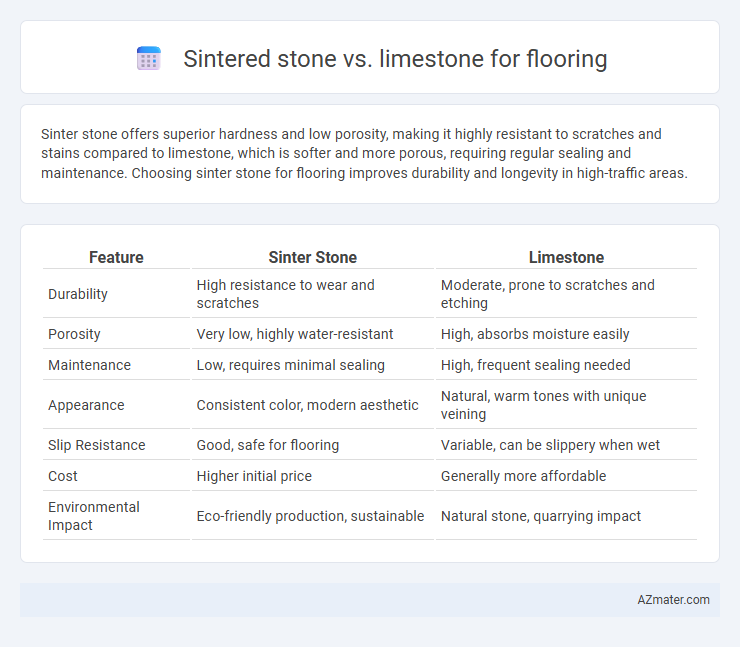Sinter stone offers superior hardness and low porosity, making it highly resistant to scratches and stains compared to limestone, which is softer and more porous, requiring regular sealing and maintenance. Choosing sinter stone for flooring improves durability and longevity in high-traffic areas.
Table of Comparison
| Feature | Sinter Stone | Limestone |
|---|---|---|
| Durability | High resistance to wear and scratches | Moderate, prone to scratches and etching |
| Porosity | Very low, highly water-resistant | High, absorbs moisture easily |
| Maintenance | Low, requires minimal sealing | High, frequent sealing needed |
| Appearance | Consistent color, modern aesthetic | Natural, warm tones with unique veining |
| Slip Resistance | Good, safe for flooring | Variable, can be slippery when wet |
| Cost | Higher initial price | Generally more affordable |
| Environmental Impact | Eco-friendly production, sustainable | Natural stone, quarrying impact |
Introduction to Sinter Stone and Limestone Flooring
Sinter stone flooring offers exceptional durability and resistance to wear, making it ideal for high-traffic areas, while limestone flooring provides a natural, warm aesthetic with its unique texture and color variations. Sinter stone is manufactured through a process that fuses mineral particles under high heat and pressure, resulting in a dense, non-porous surface resistant to stains and moisture. Limestone, a sedimentary rock primarily composed of calcium carbonate, requires sealing to protect against water damage but brings an elegant, classic look to interior and exterior floors.
Material Composition and Manufacturing Process
Sinter stone, composed primarily of compressed quartz and other natural minerals, undergoes a high-temperature sintering process that enhances its density and durability, making it ideal for flooring applications requiring high wear resistance. Limestone, mainly consisting of calcium carbonate, is typically quarried and cut without extensive thermal treatment, resulting in a softer, more porous material that is susceptible to scratching and staining. The manufacturing process of sinter stone involves pressing and heating raw materials at temperatures exceeding 1200degC, whereas limestone flooring relies on natural stone cutting and polishing methods.
Durability and Longevity Comparison
Sintered stone offers superior durability and longevity compared to limestone due to its dense, non-porous structure that resists scratches, stains, and weathering effectively. Limestone, while aesthetically pleasing with its natural texture, is softer and more prone to erosion, chipping, and staining over time, especially in high-traffic areas. For flooring applications requiring long-term resilience, sintered stone provides a more robust and low-maintenance solution, extending the lifespan of the surface significantly.
Aesthetic Appeal and Design Versatility
Sinter stone offers a sleek, uniform appearance with a polished finish that enhances contemporary and minimalist flooring designs, while limestone provides natural, earthy textures and warm tones that suit rustic and classic interiors. The color range of sinter stone is typically limited but consistent, allowing for seamless, modern aesthetics, whereas limestone varies widely in patterns and hues, contributing to unique, personalized design options. Both materials are valued for their durability, but the choice between sinter stone and limestone ultimately depends on the desired visual impact and architectural style.
Maintenance and Cleaning Requirements
Sinter stone flooring offers superior durability and low porosity, making it highly resistant to stains and easier to clean with minimal effort compared to limestone. Limestone's porous nature demands regular sealing and gentle cleaning agents to prevent damage and discoloration from spills and dirt buildup. Maintenance for sinter stone typically involves simple sweeping and occasional mopping, whereas limestone requires more frequent and careful upkeep to maintain its appearance and structural integrity.
Resistance to Staining, Scratching, and Water
Sinter stone offers superior resistance to staining, scratching, and water compared to limestone, making it highly durable for flooring applications in high-traffic areas. Its dense, non-porous surface repels liquids and minimizes surface damage, whereas limestone's softer, porous nature tends to absorb stains and show scratches more easily. The enhanced hardness and low permeability of sinter stone ensure long-lasting aesthetic appeal and easier maintenance over time.
Environmental Impact and Sustainability
Sinter stone flooring offers superior environmental benefits compared to limestone, as it is manufactured using natural raw materials with minimal processing, resulting in lower carbon emissions and reduced resource depletion. Limestone extraction often involves quarrying, which can lead to habitat disruption, soil erosion, and significant ecological footprints. Choosing sinter stone supports sustainability by promoting durability, recyclability, and eco-friendly production methods aligned with green building standards.
Cost Analysis: Sinter Stone vs. Limestone
Sinter stone flooring typically incurs higher upfront costs compared to limestone due to its advanced manufacturing process and durability. Limestone offers a more budget-friendly option with lower material and installation expenses but may require more maintenance over time. When factoring in lifecycle costs, sinter stone's long-term resilience often delivers better value despite the initial investment.
Installation Process and Considerations
Sintered stone flooring offers a more complex installation process compared to limestone due to its higher density and hardness, requiring specialized tools like diamond blades and professional skill for precise cutting and fitting. Limestone is softer and easier to work with, allowing for faster installation using standard tile cutting tools but demands careful sealing to prevent staining and damage. Consider the subfloor preparation and moisture levels carefully for both materials, as sintered stone tolerates moisture better, whereas limestone requires a well-sealed and dry substrate to maintain durability.
Choosing the Right Flooring: Sinter Stone or Limestone?
Sinter stone offers superior durability and resistance to scratches and stains, making it ideal for high-traffic flooring areas, while limestone provides a natural, classic aesthetic with a softer texture that may require more maintenance. Choosing between sinter stone and limestone depends on balancing durability needs against desired appearance and ongoing upkeep. Consider the specific environment, foot traffic, and maintenance willingness to select the most suitable flooring material for long-lasting performance and visual appeal.

Infographic: Sinter stone vs Limestone for Flooring
 azmater.com
azmater.com